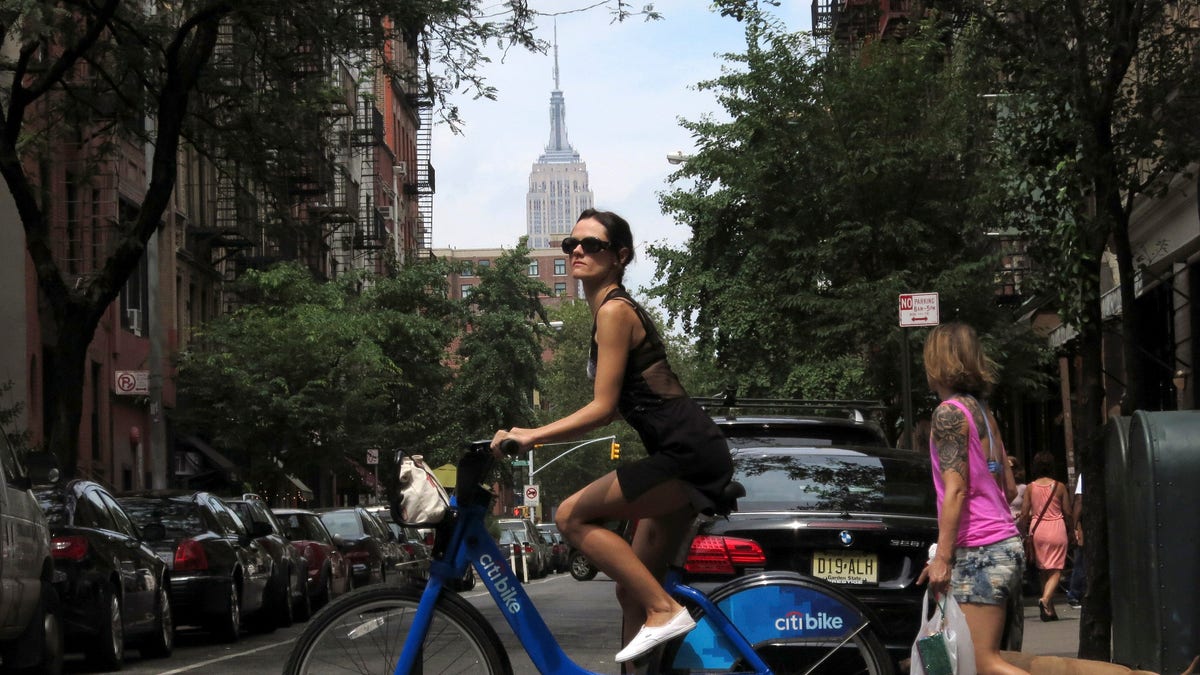
The Empire State Building is seen in the distance as a woman rides a Citibike in the Soho neighbourhood of New York July 27, 2013. REUTERS/Gary Hershorn
Urban bicycle-sharing programs that let people borrow wheels instead of buying them may help many adults get more exercise, an international study suggests.
Researchers found that 60 percent of participants in recently launched programs in Melbourne and Brisbane, London, Washington, D.C. and the Minneapolis/St. Paul metropolitan area switched from sedentary forms of travel to cycling.
“The type of sedentary mode of travel – public transport, car, taxi – that is being substituted by bike share depends very much on the transport system available,” lead study author Dr. Elliot Fishman, director of the Institute for Sensible Transport in Australia, said by email.
Globally, physical inactivity is the fourth leading cause of death, contributing to an estimated 3.2 million fatalities each year, according to the World Health Organization. Regular exercise such as walking, cycling or participating in sports can help reduce the risk of obesity, heart disease, diabetes, depression and some cancers.
Adults aged 18 to 64 years old should get a minimum of 150 minutes of moderate intensity aerobic activity or at least 75 minutes of vigorous exercise each week, WHO recommends. For more health benefits, though, people should get twice that amount of exercise and include both aerobic and muscle-strengthening workouts.
More than 800 cities worldwide offer bikeshare programs, in part to encourage residents to get more exercise, Fishman and colleagues report in the Journal of Transport and Health.
All of the bikeshare programs they analyzed in the study used electronic payment and tracking systems, allowing researchers to see the distance and duration of every trip.
The researchers reviewed data for every bike trip recorded in 2012. With the exception of Minneapolis/St. Paul, which operates only from April through November, each of the programs runs 365 days a year.
To understand how often cycling replaced other forms of transport, researchers asked members of the bikeshare programs to participate in online surveys about their travel habits.
Many bikeshare trips replaced public transit or walking, the study found.
London, where fewer people drive than in other cities, had the lowest proportion of bike trips replacing car travel.
The proportion of travel replacing public transit, car or taxi with bikes ranged from 51 percent in Minneapolis/St. Paul to 68 percent in both Brisbane and London.
In Minneapolis/St. Paul, bike trips were more likely to replace travel people previously did on foot, whereas in London cycling more often replaced public transit and in Brisbane more people abandoned cars for bikes.
“As car use is more convenient in Brisbane than London, a relatively high proportion of Brisbane bike share trips substitute for the car,” Fishman said.
When biking replaces walking, total active travel time drops, the researchers note, because walking is active too, and takes longer. Still, they estimated that bikeshare programs netted increases in active travel time – from an additional 1.4 million minutes in Minneapolis/St. Paul to an additional 74 million minutes in London.
The main reason that bike share replaces sedentary travel is what’s known as the last mile problem, said Daniel Fuller, a public health researcher at the University of Saskatchewan in Canada.
“Bike share helps people quickly and easily finish the last leg of their trip,” Fuller, who wasn’t involved in the study, said by email. Cycling might, for example, eliminate a half-mile walk from the subway to the office, or remove the need to spend a half hour searching for parking.
Shorter trips may make it more likely that people switch to bikes from cars, said Raja Jurdak, of the Commonwealth Scientific Industrial and Research Organization in Australia.
“People whose origin and destination are close to bike share stations are obviously more likely to use the system,” Jurdak, who wasn’t involved in the study, said by email.
The health benefits of bikeshare programs would be most pronounced when people replace inactive travel with cycling, Fuller noted. It’s less clear whether people would be healthier from spending longer periods of time doing lower-intensity exercise like walking or from devoting shorter stretches of time to more vigorous activity like biking, he said.
“There is a health benefit to both walking and cycling,” Fuller said. “If the choice is between walking and cycling, I think additional factors like time and convenience should drive the decision rather than health.”
